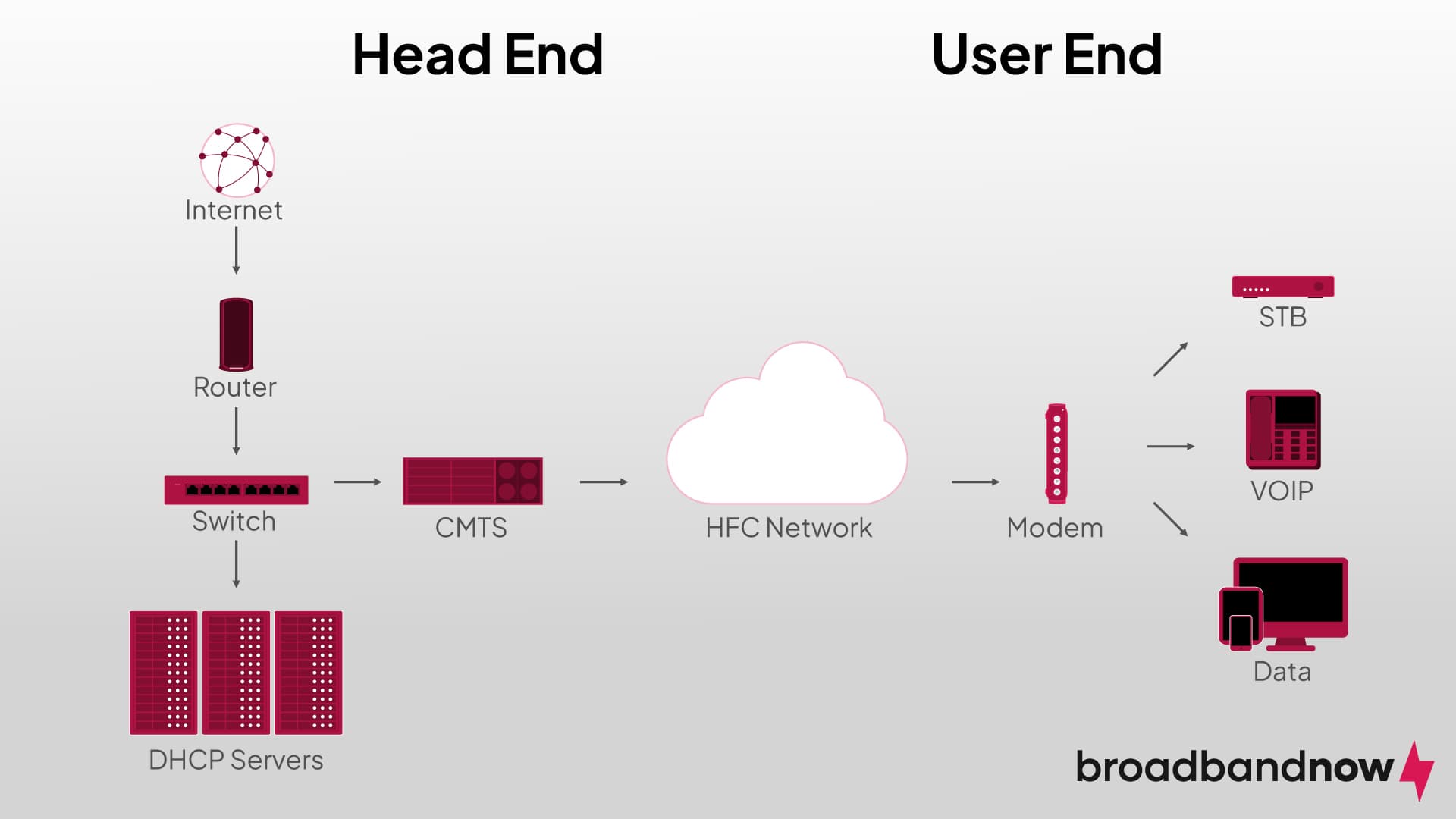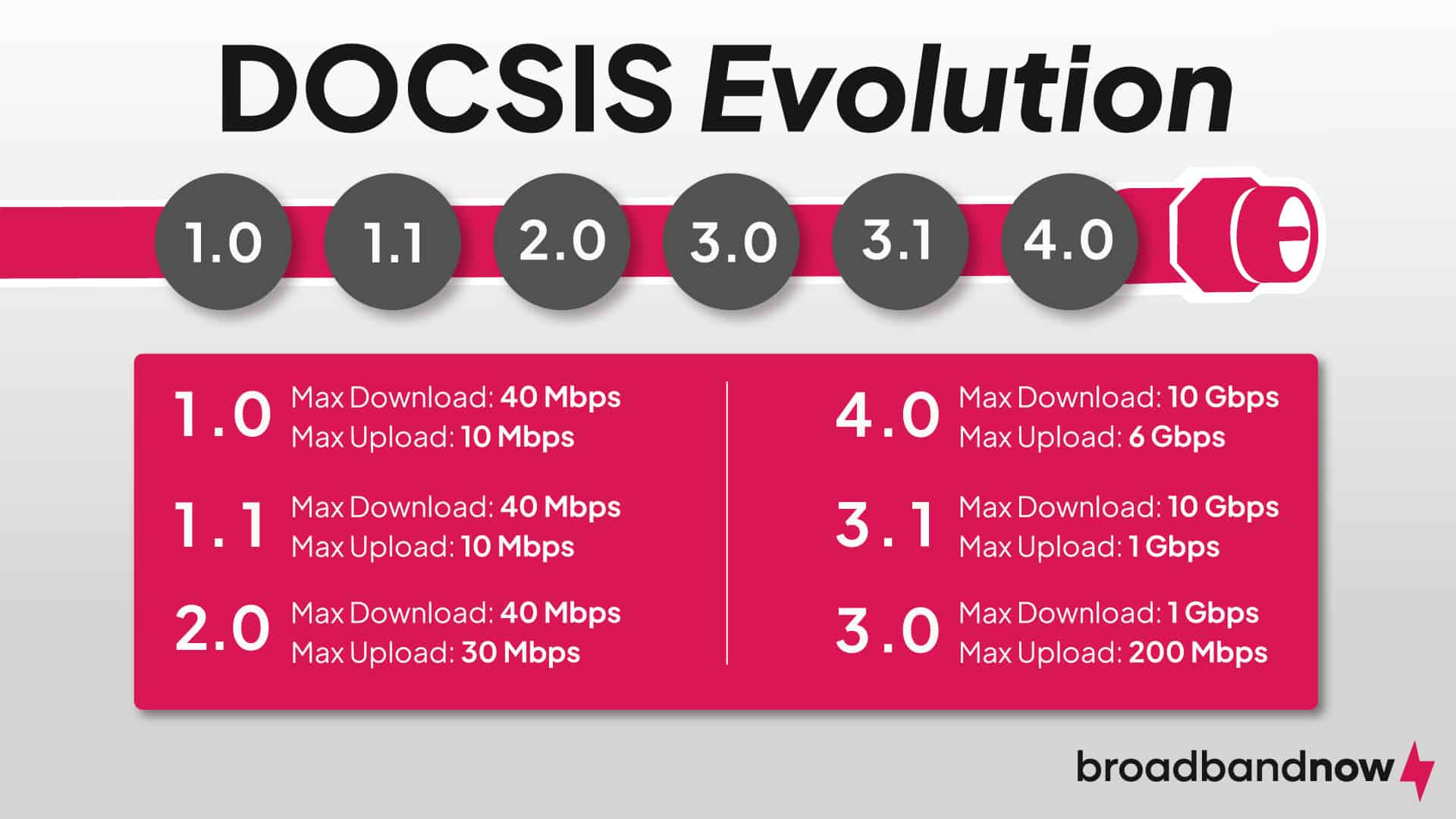DOCSIS: The Evolution and Future of Cable Internet Connectivity
Millions of Americans rely on DOCSIS daily. The new 4.0 standard is now here, bringing faster speeds than ever thought possible on a cable subscription.
-

The evolution of DOCSIS allows cable internet to increase its speeds and efficiency. (Image by BroadbandNow Design)
- DOCSIS 4.0 will change the landscape of cable internet technology by increasing speeds and efficiency.
- Cable internet is already well established through a massive network of coaxial cables, so it’s not likely to become antiquated any time soon.
- There are multiple underlying technologies that make DOCSIS able to enhance the quality of cable internet connections.
DOCSIS is a testament to the cable industry’s commitment to innovation and adaptation, remaining competitive against fiber-optic networks, increasing demand for bandwidth, and integrating cutting-edge technologies. As the world embraces more digital access, we’re diving into how DOCSIS will continue to shape connections with its newest iteration, as well as covering how it evolved over the past few decades. We’ll also answer the question many consumers are asking: when will DOCSIS 4.0 modems be available?
Overview of DOCSIS
- What Is DOCSIS?
- How Does DOCSIS Work?
- What Is the History of DOCSIS?
- What Technology Does DOCSIS Use?
- How Does DOCSIS Stack Up Against Other Connectivity Technologies?
- What Is the Future of DOCSIS?
- What Are the Key Features of DOCSIS 4.0?
- When Will DOCSIS 4.0 Be Available?
- Looking Ahead: Will DOCSIS Ever Become Obsolete?
What Is DOCSIS?

DOCSIS, or data over cable service interface specification, is an international standard for transmitting data over coaxial cables. It’s the same technology cable television subscribers have used to receive programming for decades.
Endorsed initially by the International Telecommunications Union, a specialized branch of the United Nations, and then further developed by CableLabs in Colorado, DOCSIS is essential to cable internet advancement.
How Does DOCSIS Work?

Simply put, DOCSIS uses a cable TV channel to transmit data to and from a modem via a coaxial cable. Unlike a channel you can watch on television, this channel refers to the one through which you receive an internet connection, cable TV, and other services you subscribe to from your cable provider.
What Is the History of DOCSIS?
DOCSIS emerged in the late 1990s, born from a need to standardize high-speed data transfer over cable television system networks. Its creation addressed the early challenges of cable internet, offering a more streamlined and efficient approach to data transmission.

As DOCSIS evolved, each iteration brought new advancements in download and upload speeds, quality of transmission, and advanced security features. DOCSIS 4.0 will be a tremendous leap forward for cable internet connections.
- DOCSIS 1.0 (1997): At the start, DOCSIS 1.0 provided a foundation with its basic features but had limitations, especially regarding upstream bandwidth.
- DOCSIS 1.1 (2001): This version introduced quality-of-service enhancements, paving the way for modern voice over internet protocol (VoIP) services.
- DOCSIS 2.0 (2002): With new modulation schemes, DOCSIS 2.0 notably increased upstream bandwidth, addressing a fundamental limitation of its predecessors.
- DOCSIS 3.0 (2006): This iteration was a game changer. DOCSIS 3.0 introduced channel bonding, IPv6 support, and fortified security features, pushing the boundaries of speed and efficiency.
- DOCSIS 3.1 (2013): The first version to support orthogonal frequency division multiplexing (OFDM), DOCSIS 3.1 further increased capacity and reduced latency, setting new industry standards.
- DOCSIS 4.0 (2019): While not yet widely available, DOCSIS 4.0 is expected to significantly increase upload speeds, which is expected to compete with the symmetrical speeds of fiber internet.
What Technology Does DOCSIS Use?
In many ways, DOCSIS serves as the bridge between cable modems and cable modem termination systems. That connection occurs over hybrid fiber-coaxial (HFC) networks, which combine the high data-transfer rates of fiber optics with the widespread availability of coaxial cables. DOCSIS uses numerous technologies in unison to deliver higher speeds and better security than ever before.
Architecture and Functionality
- Channel bonding: Introduced in DOCSIS 3.0, channel bonding allows the simultaneous use of multiple channels for data transmission. That ability enhances bandwidth and provides redundancy, ensuring consistent connectivity even if one channel faces issues.
- Orthogonal frequency division multiplexing (OFDM): A key feature of DOCSIS 3.1 and beyond, OFDM divides a single data stream across multiple closely spaced carriers, optimizing data transfer and reducing interference.
- Full duplex communication: This standard allows data to be transmitted and received simultaneously, leading to symmetrical upload and download speeds, which is crucial for applications such as video conferencing and online gaming.
- Extended spectrum capabilities: There’s a push toward using a broader frequency spectrum with DOCSIS 4.0, and technologists are aiming to achieve up to 1.8 GHz. The extended spectrum ensures more channels for data transfer, translating to higher speeds and more reliable connections.
How Does DOCSIS Stack Up Against Other Connectivity Technologies?
DOCSIS (and cable internet as a whole) has its strengths — especially in areas with existing cable infrastructure — but it faces competition from DSL, 5G home internet, fiber, and satellite connections. Each connection type has its advantages: DSL and 5G home internet are widely available, fiber offers ultra-high symmetrical speeds, and satellite internet can reach even the most remote areas. The continuous evolution of DOCSIS, however, ensures its relevance in the ever-changing internet landscape.
What Is the Future of DOCSIS?
DOCSIS’s role remains crucial as we venture deeper into the 5G era. Its adaptability and continuous upgrades position it to meet future challenges, ensuring its place in the next decade and beyond. Since cable infrastructure is ubiquitous compared to more advanced technologies, such as fiber internet, it will be a while before cable becomes irrelevant in the internet space.
What Are the Key Features of DOCSIS 4.0?
DOCSIS 4.0 represents the next generation of broadband technology over cable’s HFC networks. Building on the foundation of its predecessors, DOCSIS 4.0 is poised to redefine internet connectivity standards, ensuring that users have access to cutting-edge services for years to come. Below are the main enhancements DOCSIS 4.0 will deliver.
Enhanced Speeds
DOCSIS 4.0 supports up to 10 Gbps downstream capacity and up to 6 Gbps upstream capacity. That substantial increase in downstream and upstream capabilities will ensure users enjoy multi-gigabit symmetrical services over HFC networks.
Support for Emerging Applications
As new technologies and applications emerge, such as interactive video conferencing, remote learning, health care applications, Internet of Things, and virtual reality, the symmetrical speeds offered by DOCSIS 4.0 become increasingly relevant.
Efficient Use of Existing Infrastructure
One of the major advantages of DOCSIS 4.0 is its ability to increase the effectiveness of existing cable broadband networks without the need for additional cabling. That efficiency results in significant cost savings and ensures the infrastructure is future-proof.
A Step Toward 10G
DOCSIS 4.0 is a crucial milestone in the industry’s journey toward achieving its goal of 10G internet (10 Gbps speeds). With the integration of full duplex and extended-spectrum capabilities, DOCSIS 4.0 is set to deliver on the promise of 10 Gbps over HFC networks.
When Will DOCSIS 4.0 Be Available?
-

DOCSIS 4.0 will be here sooner rather than later, if not already. (Image by BroadbandNow Design)
CableLabs released the initial specifications for DOCSIS 4.0 back in 2019. In 2023, many cable providers ran small market tests in North American cities, with a broader release expected by 2025. Comcast customers in select major metro areas were part of an initial rollout of DOCSIS 4.0 around September 2024, with expansion slowly being rolled out through 2025 and 2026.
When Will DOCSIS 4.0 Modems Be Available?
Even though DOCSIS 4.0 has been in the works for a few years, it’s still slowly making its way to consumers. The technology itself is ready, but manufacturers and internet providers are taking time to test, certify, and roll it out.
Right now, only a few providers, like Xfinity, have started offering DOCSIS 4.0 service in select cities such as Atlanta and Philadelphia. That means the network side of things is starting to take shape, but most people still don’t have access to DOCSIS 4.0 modems just yet.
As of 2025, retail DOCSIS 4.0 modems haven’t widely hit store shelves. Experts expect that to change within the next year or so as cable companies expand their DOCSIS 4.0 coverage and modem makers ramp up production. If you’re planning to upgrade, you’ll likely start seeing DOCSIS 4.0-ready modems from major brands appear in 2026.
Looking Ahead: Will DOCSIS Ever Become Obsolete?
As the demand for faster internet and more reliable connections continues to grow, DOCSIS 4.0’s advancements will be essential to keeping cable internet relevant in the coming decades.
Despite years of speculation about DOCSIS’s potential decline, CableLabs’ new standard is poised to shake up the market once again. The goal of DOCSIS 4.0 is to ensure the longevity of HFC network technology and prevent it from being overtaken entirely by pure fiber networks.
Even with fierce competition, DOCSIS isn’t backing down. With renewed vigor in the HFC domain, the industry is gearing up to fight fiber with fiber. Will it be enough? Only time will tell.
Frequently Asked Questions About DOCSIS 4.0
Is DOCSIS 4.0 backward compatible?
DOCSIS 4.0 is backward compatible with previous DOCSIS versions, including 3.0 and 3.1. This means cable operators can upgrade their networks without replacing all existing hardware, allowing you to continue using your current devices while gradually transitioning to newer technology. This compatibility helps minimize service disruptions and reduces upgrade costs for both providers and consumers.
Is DOCSIS better than fiber?
While DOCSIS is cost-effective for leveraging existing cable networks, fiber offers unmatched speed and reliability. DOCSIS 4.0 supports gigabit speeds and lower latency but can’t match the symmetrical speeds of fiber. Fiber is better for long-term scalability, but DOCSIS is more practical for areas where laying new fiber lines isn’t feasible.
Is DOCSIS 3.0 obsolete?
DOCSIS 3.0 isn’t entirely obsolete but is becoming outdated as operators increasingly adopt DOCSIS 3.1 and 4.0 for higher speeds and better efficiency. DOCSIS 3.0 supports speeds up to 1 Gbps, which may suffice for many users, but newer versions address the growing demand for faster, more reliable internet.
What is the difference between DOCSIS 4.0 and GPON?
DOCSIS 4.0 uses coaxial cable infrastructure and GPON (Gigabit Passive Optical Network) is a fiber-optic technology. DOCSIS 4.0 provides up to 10 Gbps downstream and 6 Gbps upstream, leveraging existing cable systems. GPON offers symmetrical speeds and better reliability, making it ideal for high-demand speed needs. Fiber typically outperforms DOCSIS in scalability and future-proofing but is more expensive to use.
Should you wait for DOCSIS 4.0 or buy a DOCSIS 3.1 modem now?
You can still buy a DOCSIS 3.1 modem. DOCSIS 3.1 continues to deliver gigabit speeds and will remain fully supported for years to come. DOCSIS 4.0 modems aren’t widely available yet, and even once they are, most internet providers will take time to upgrade their networks.
Will DOCSIS 4.0 replace fiber?
DOCSIS 4.0 is designed to make cable internet faster (up to 10 Gbps, in theory) and more competitive with fiber, but it doesn’t replace fiber technology. Fiber internet still uses glass strands to transmit data via light, offering extremely low latency and symmetrical speeds. DOCSIS 4.0 helps cable providers deliver similar multi-gig performance without having to rebuild their entire infrastructure with fiber lines.